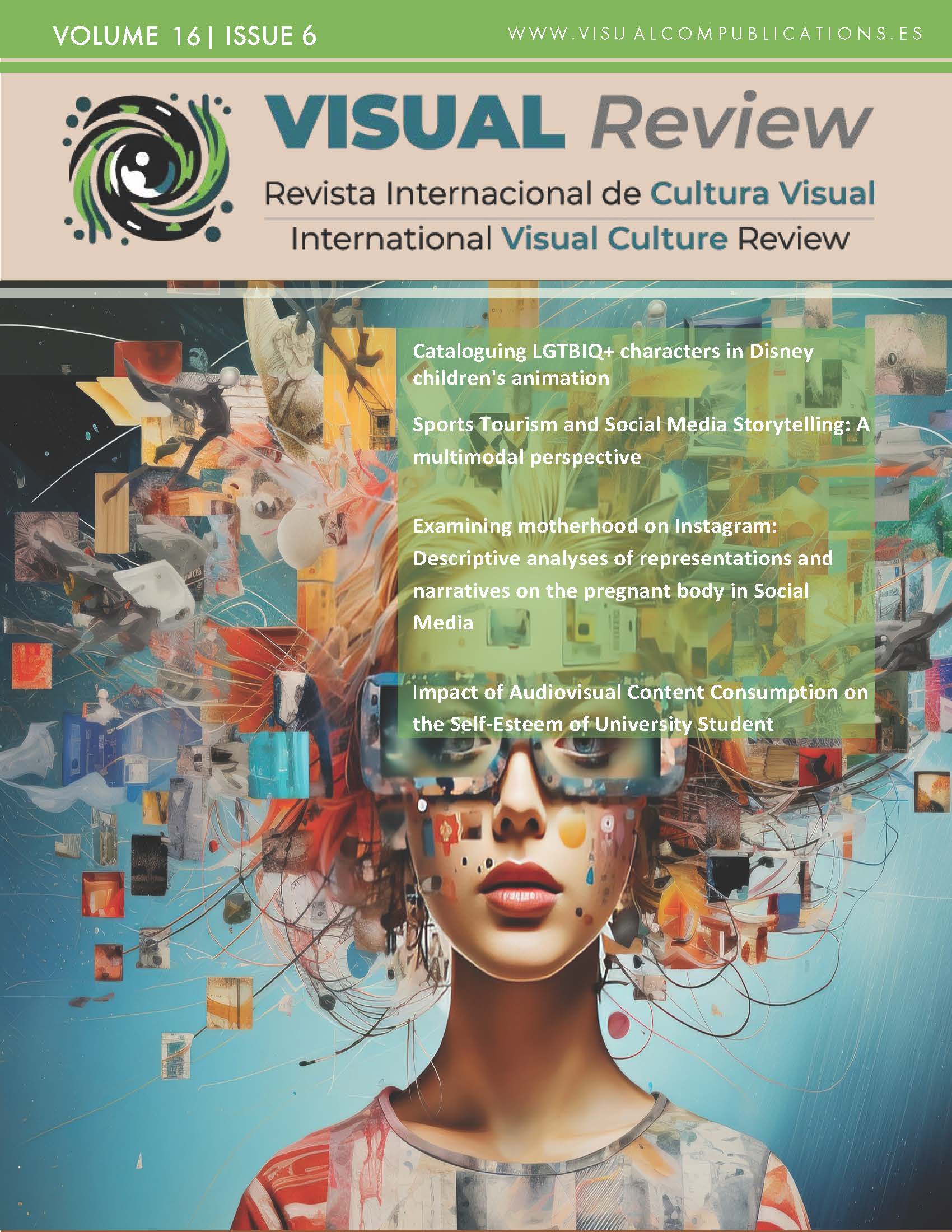The Rhetoric of Disability on Instagram
A Post-Qualitative Photographic Analysis
DOI:
https://doi.org/10.62161/revvisual.v16.5318Keywords:
Disability, Social Networks, Digital Influencers, Photographs, Instagram, Inclusion, Digital cultureAbstract
Social networks, such as Instagram, have flourished samples of realistic images of disability produced by the group itself, offering a discourse that is different from the traditional one, more radical and diverse. This work, through a post-qualitative photographic analysis of 100 photographs from 54 Instagram profiles, seeks to define a new rhetoric of disability to update the rhetoric of disability proposed by Garland-Thomson (2001), but in the 3.0 web. The new classifications speak of emancipation, sexuality, happiness, super-capacity, rebellion and pride, in order to normalize the group and allow its inclusion and equality.
Downloads
Global Statistics ℹ️
|
343
Views
|
145
Downloads
|
|
488
Total
|
|
References
Arnau-Ripollés, S. (2019). Estudios críticos de y desde la diversidad funcional. [Tesis doctoral, UNED]. Universidad Nacional de Educación a Distancia (España) http://e-spacio.uned.es/fez/view/tesisuned:ED-Pg-Filosofia-Msarnau
Ballestín-González, B. & Fàbregues-Feijoó, S. (2018). La práctica de la investigación cualitativa en ciencias sociales y de la educación. Barcelona: Editorial UOC.
Barthes, R. (1999). La cámara lúcida. Barcelona: Ediciones Paidós Ibérica, S.A.
Ellingson, L. L., & Sotirin, P. (2020). Data engagement: A critical materialist framework for making data in qualitative research. Qualitative Inquiry, 26(7), 817–826. https://doi.org/10.1177/1077800419846639
García-Borrego, M. & González-Cortés, M. E. (2022). Cultural journalism and disability in cinema: A view of its historical evolution through specialized critique. VISUAL REVIEW. International Visual Culture Review. Revista Internacional De Cultura Visual, 11(4), 1–16. https://doi.org/10.37467/revvisual.v9.3691
García-Cantero, M.J. (2021). Supracapacidades y diversidad funcional. Nuevas perspectivas para el empleo. Cuadernos de la Cátedra Número 1, Cátedra UOC Randstad. Universitat Oberta de Catalunya. http://hdl.handle.net/10609/128086
García-Santesmases Fernández, A. (2016). Cuerpos (Im)pertinentes: Un análisis queer-crip de las posibilidades de subversión desde la diversidad funcional. [Tesis doctoral, Universitat de Barcelona]. Dipòsit Digital de Ia UB. http://diposit.ub.edu/dspace/bitstream/2445/109589/4/AGSF_TESIS.pdf
García-Vena, C. (2020). Irrompible. El arte de levantarse siempre una vez más. Barcelona: Centro de Libros PAPF, SLU.
Garland-Thomson, R. (2001). Seeing the Disabled, visual rhetorics of Disability in Popular Phoography. En Longmore P.K. & Umansky, L. (2001). The new disability History (pp. 335-374). New York and London: NEW YORK UNIVERSITY PRESS. https://www.ces.uc.pt/projectos/intimidade/media/Seing%20the%20disabled_visual%20rhetorics%20of%20disability%20in%20popular%20photography.pdf
Hu, Y., Manikonda, L., & Kambhampati, S. (2014). What we Instagram: A First Analysis of Instagram photo content and user types. En Proceedings of the 8th International Conference on Weblogs and Social Media, ICWSM 2014 (pp. 595-598). (Proceedings of the 8th International Conference on Weblogs and Social Media, ICWSM 2014). The AAAI Press. https://doi.org/10.1609/icwsm.v8i1.14578
Huerta, R. (2021). La imagen como experiencia. Editorial Aula Magna. McGraw-Hill Interamericana de España S.L.
Jackson, A. Y., & Mazzei, L. (2012). Thinking with theory in qualitative research: Viewing data across multiple perspectives. Routledge.
Kafai, S. (2021). Crip Kinship, the Disability Justice & Art Activism of Sins Invalid. Vancouver: Arsenal Pulp Press.
Martín-García, M. T., & Martínez-Solana, M. Y. (2019). Women illustrators on Instagram: digital influencers more committed to gender equality in social networks. VISUAL REVIEW. International Visual Culture Review. Revista Internacional De Cultura Visual, 6(2), 59–68. https://doi.org/10.37467/gka-revvisual.v6.1889
Marzal-Felici, J. (2007). Cómo se lee una fotografía. Interpretaciones de la mirada. Madrid: Ediciones Cátedra (Grupo Anaya, S.A.).
Morris, J. (1991). Pride against Prejudice, transforming attitudes to disability. London: The Women’s Press.
Oliver, M. (1990). The Politics of Disablement. Basingstoke: Macmillan.
Parra-Gómez, S. (2023). Retos del uso de los medios sociales por parte del colectivo de personas con discapacidad. En Osuna-Acedo, S. & Feltrero, R. (2023). Alfabetización mediática crítica: desafíos para el siglo XXI (pp.254-271). Editorial Aula Magna, McGraw-Hill.
Parra-Gómez, S., Planella-Ribera, J., & Hernández-Albarracín, J.D. (2024). Redes sociales y discapacidad: una descripción sobre las consecuencias positivas y negativas de su encuentro. Encuentros. Revista De Ciencias Humanas, Teoría Social Y Pensamiento Crítico, 20 (enero-abril), 24–35. https://doi.org/10.5281/zenodo.10032084
Sanz-Simón, L. (2022). The construction of characters with disabilities in film: The importance of verbal and non-verbal communication. VISUAL REVIEW. International Visual Culture Review. Revista Internacional De Cultura Visual, 11(4), 1–16. https://doi.org/10.37467/revvisual.v9.3701
Senent-Ramos, M. (2017). Ana te presta su espejo: aspectos básicos sobre la diversidad funcional. Editorial ACEN.
Downloads
Published
How to Cite
Issue
Section
License
Copyright (c) 2024 VISUAL REVIEW. International Visual Culture Review / Revista Internacional de Cultura Visual

This work is licensed under a Creative Commons Attribution-NoDerivatives 4.0 International License.
Those authors who publish in this journal accept the following terms:
-
Authors retain copyright.
-
Authors transfer to the journal the right of first publication. The journal also owns the publishing rights.
-
All published contents are governed by an Attribution-NoDerivatives 4.0 International License.
Access the informative version and legal text of the license. By virtue of this, third parties are allowed to use what is published as long as they mention the authorship of the work and the first publication in this journal. If you transform the material, you may not distribute the modified work. -
Authors may make other independent and additional contractual arrangements for non-exclusive distribution of the version of the article published in this journal (e.g., inclusion in an institutional repository or publication in a book) as long as they clearly indicate that the work was first published in this journal.
- Authors are allowed and recommended to publish their work on the Internet (for example on institutional and personal websites), following the publication of, and referencing the journal, as this could lead to constructive exchanges and a more extensive and quick circulation of published works (see The Effect of Open Access).













